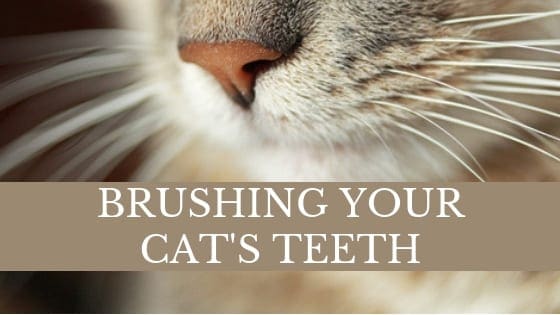
The thought of having to brush your cat’s teeth may seem a bit silly to you but it’s actually an important part of maintaining her health.
To make it easier on everybody (cat and human), don’t attempt to brush every tooth in your cat’s mouth the very first time. As with many things in a cat’s life, it’s much less stressful if this process is introduced gradually and under positive conditions. Coming at your cat with a toothpaste-covered toothbrush without easing into the process isn’t going to be well received.
Getting Started
The first thing to do is to get your cat used to the idea of having her mouth touched. When your cat is in a receptive mood and enjoying some petting from you, gently stroke around the head and then along the sides of her mouth. Work up to sliding your finger along the lips and then advance to gently rubbing the teeth. This may take several sessions to work up to this point so don’t be discouraged. Offer a reward during each step. If you’re clicker training, click and reward even the smallest positive steps.
Types of Brushes
There are multiple options when it comes time to actually start brushing your cat’s teeth. At your local pet product store you can find finger toothbrushes, pet toothbrushes, teeth-cleaning pads, and oral hygiene sprays. Choose the type you think your cat will accept more readily. You may have to experiment with a couple of types. As for the oral spray, save that for if you truly decide you’re unable to brush your cat’s teeth. If you have any questions about oral sprays, talk to your veterinarian.
If you don’t feel comfortable with any of the choices at the pet product store, you can try using a baby toothbrush. They’re small, gentle and easy to handle. You can even wrap a small piece of soft gauze around your finger. Just make sure you don’t rub and irritate the cat’s gums.
Types of Toothpaste
Choose one specifically made for pets. Don’t use toothpaste designed for human use because it can burn the cat’s tongue, throat and stomach. Pet toothpastes usually come in a variety of flavors to make them more appealing.
If you can’t brush the teeth, there are oral sprays as well as food or water additives. Ask your veterinarian.
Keep it Quick and Fun
It may be a stretch to consider tooth brushing a fun activity, but if you keep the process quick and casual, it’ll be over before the cat has a chance to complain. With my cat, I engage her in an interactive play session after tooth brushing as a reward for being patient.
Ideally, you should brush your cat’s teeth daily. I’m realistic enough to know many people aren’t going to do that so at the very least, try to maintain a schedule of two or three times a week. Even once a week is better than nothing.
Oral Health is Serious Business
Routinely examine your cat’s mouth to check for signs of gingivitis. Look for red or inflamed gums, check for bad breath or other signs indicating a potential medical problem. If your cat has trouble eating, has stopped eating altogether, has bad breath, excessively drools or paws at her mouth frequently, there may be a dental problem going on needing medical attention.
Need More Information?
For more information on cat behavior and training, refer to the best-selling books by Pam Johnson-Bennett. Pam’s books are available at bookstores and online. We’ve included links to Amazon here on our website.
If you have a question regarding your cat’s behavior or health, please contact your veterinarian. This article is not intended as a replacement for your cat’s veterinary care. This article is for information purposes only and not offering medical advice or providing a medical diagnosis.
 Problem Solving & Advice by Pam Johnson-Bennett Cat Behavior Expert & Best-selling Author
Problem Solving & Advice by Pam Johnson-Bennett Cat Behavior Expert & Best-selling Author


